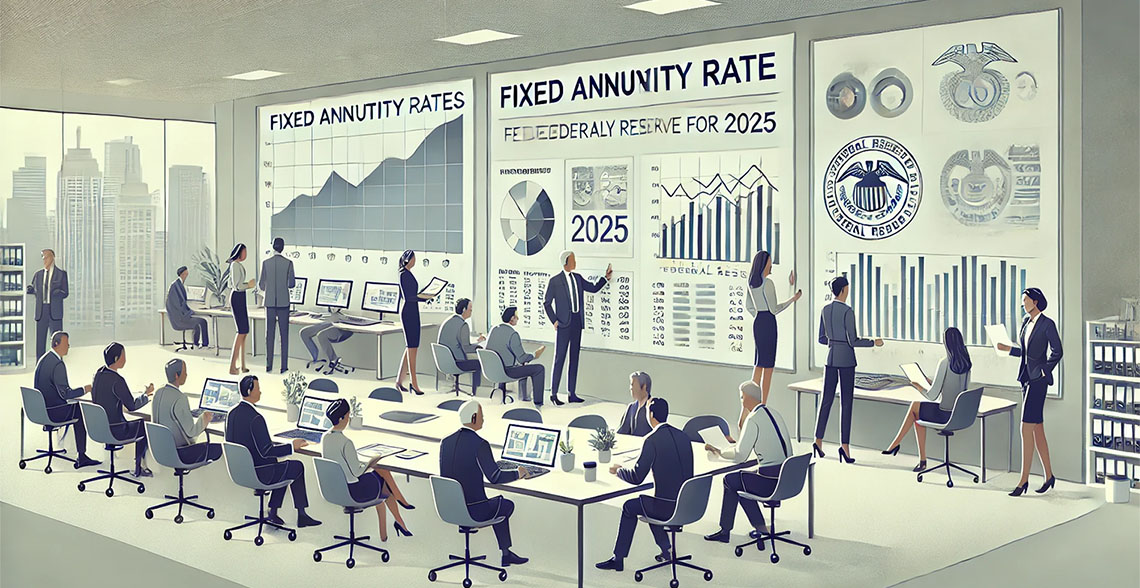
Fixed annuities offer investors a secure and predictable way to earn interest over time, especially appealing for conservative investors and retirees. As 2025 approaches, understanding the trends in fixed annuity rates is essential for making the best financial decisions. With recent Federal Reserve rate cuts and shifts in economic policy, the outlook for fixed annuity rates is mixed, but opportunities remain for savvy investors.
What Affects Fixed Annuity Rates?
Two primary factors shape fixed annuity rates: the Federal Reserve’s benchmark interest rate and the bond market.
- Federal Reserve Benchmark Rate: When the Fed changes its benchmark rate, it affects yields across a range of investments, including bonds. Lower Fed rates usually lead to declining yields for long-term bonds, which in turn influence fixed annuity rates.
- Bond Market Influence: Many fixed annuities are linked to the yields on long-term U.S. Treasury securities. When bond yields fall, annuity rates often follow. This correlation is essential for investors looking at long-term annuity options, as it can lock in rates for years.

Review of 2024 and Early 2025 Fed Rate Movements
The Federal Reserve began cutting rates in September 2024 after maintaining them at high levels for several years. The Fed’s decision reduced the federal funds rate to a range of 4.75% – 5.00%, aiming to boost economic growth and stabilize inflation. (Source: Wall Street Journal).
Looking forward, the Federal Reserve may cut rates further in 2025, with projections estimating the federal funds rate will reach around 3.4% by year’s end (Source: USA Today). These reductions aim to keep inflation in check while also sustaining economic growth.
Fixed Annuity Rate Trends for 2025
Due to these projected Fed rate cuts, it’s likely that fixed annuity rates will trend downward in 2025. Here’s what this might mean for investors:
- Gradual Rate Declines: As the federal funds rate falls, bond yields will likely decrease, bringing fixed annuity rates down. These rate cuts could mean that annuity rates in early 2025 might be higher than those later in the year.
- Influence of Broader Economic Factors: Beyond the Fed’s policy, other factors like inflation, labor market shifts, and GDP growth will impact annuity rates. Monitoring these broader economic indicators can offer insights into potential annuity rate changes.
What This Means for Fixed Annuity Buyers
Even if fixed annuity rates decline in 2025, there are still strategic opportunities for buyers:
- Locking in Rates Now: If you’re considering a fixed annuity, locking in today’s rates before additional rate cuts could be beneficial. Annuity rates often don’t adjust immediately to Fed rate changes, so now might be a prime time to secure favorable terms.
- Short-Term Fixed Annuities: Opting for a short-term annuity, like a three- or five-year term, allows you to reassess rates when they renew. If the economy changes by then, you can adjust your strategy.
- Multi-Year Guaranteed Annuities (MYGAs): MYGAs can lock in today’s rates over several years, offering stability during periods of changing rates. For investors prioritizing predictability, a MYGA may be a sound choice amid potential rate cuts.
Factors to Watch in 2025
Investors planning to purchase fixed annuities in 2025 should follow several key indicators:
- Federal Reserve Announcements: The Federal Reserve meets every six weeks, offering the latest guidance on potential rate changes. Staying informed on these announcements can provide clues about future annuity rates.
- Inflation Rates: If inflation stabilizes, it’s likely the Fed will maintain or even further reduce rates, impacting fixed annuity rates.
- Demand for Annuities: High demand for safe investments can sometimes sustain annuity rates. If fixed annuities remain popular, insurers may offer competitive rates to attract buyers.
Diversification Strategies Amid Rate Declines
Even as fixed annuity rates trend downward, combining different types of annuities can help diversify your retirement portfolio:
- Variable Annuities: These annuities are tied to the market’s performance, offering growth potential even when fixed rates decline.
- Fixed Indexed Annuities: With fixed indexed annuities, your return is tied to a stock index’s performance. These annuities offer a balance of growth potential with downside protection, making them appealing if you want some growth alongside security.
- Laddering Strategy: Laddering, or purchasing multiple annuities with different terms, can mitigate rate risk. For example, spreading investments across three-, five-, and seven-year fixed annuities lets you take advantage of varying rates over time.
How to Get the Best Fixed Annuity Rates in 2025
To maximize your return on fixed annuities, consider these tips:
- Request Multiple Quotes: Rates vary by insurer, so getting quotes from several providers can help you find the best rate.
- Check the Insurer’s Stability: Work with highly rated insurance companies to ensure your investment’s security. Companies with solid financial ratings are more likely to offer competitive, reliable terms.
- Timing Matters: If you’re inclined to lock in a fixed rate, consider doing so in early 2025 before further Fed rate cuts. Early timing may help you secure a higher rate than if you wait until mid or late 2025.
Conclusion
With fixed annuity rate trends for 2025 likely shifting downward, understanding the drivers behind these changes can help you make informed choices. Although declining rates may seem discouraging, there are still ways to make the most of fixed annuities. From locking in today’s rates to choosing shorter terms or MYGAs, there are strategic ways to adapt to the economic environment.
By staying informed on Federal Reserve actions, economic indicators, and annuity trends, you can confidently plan your financial strategy for the year ahead. Fixed annuities remain a valuable option for those seeking stable income, and with careful planning, you can make the most of them in 2025.
